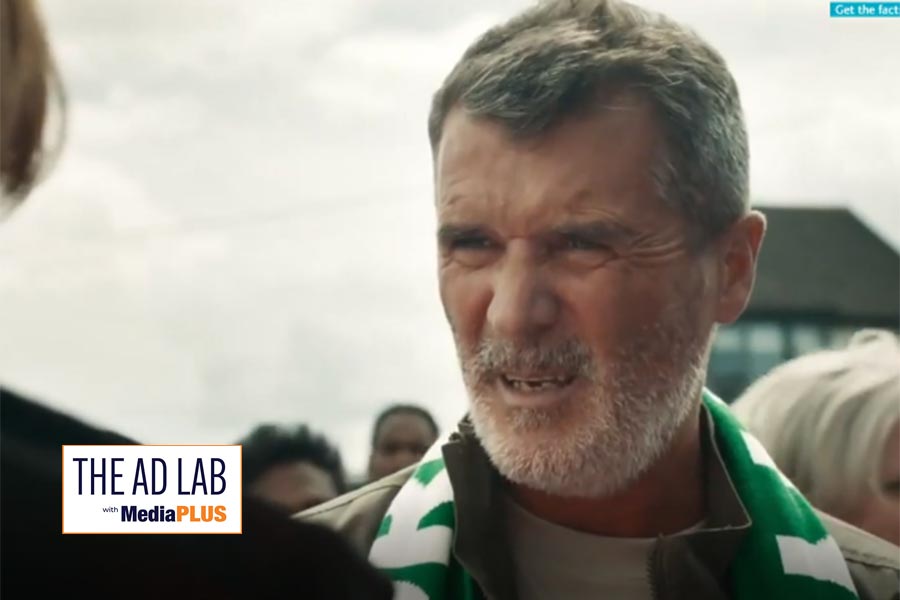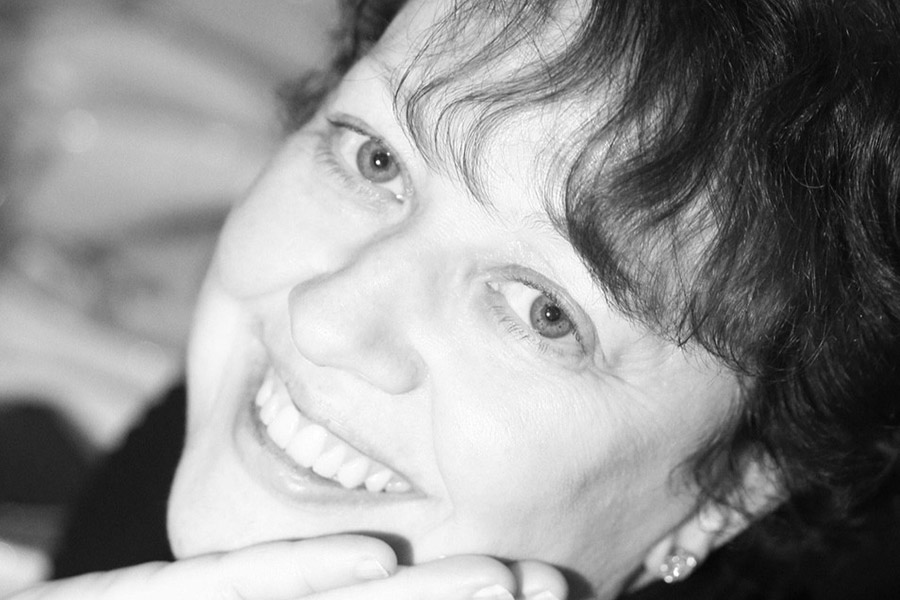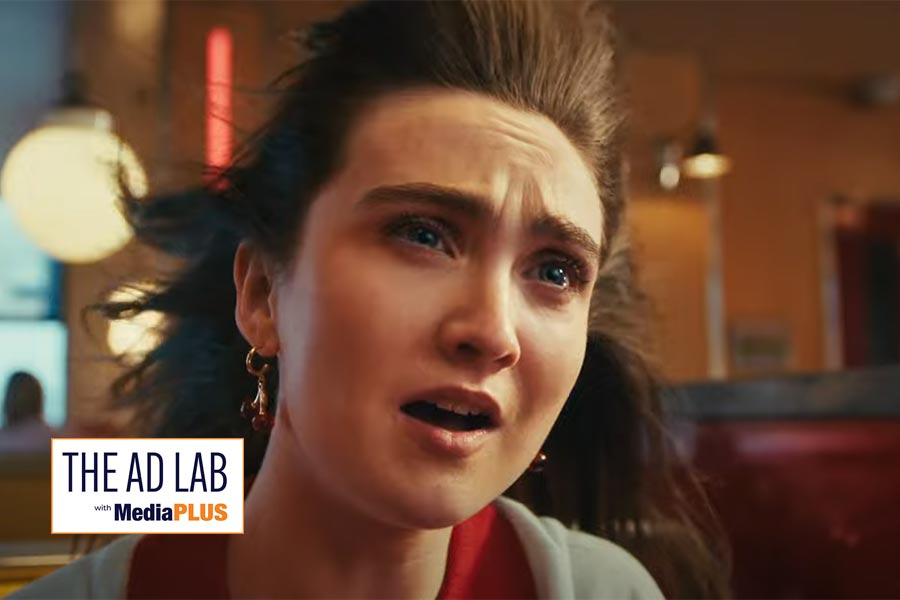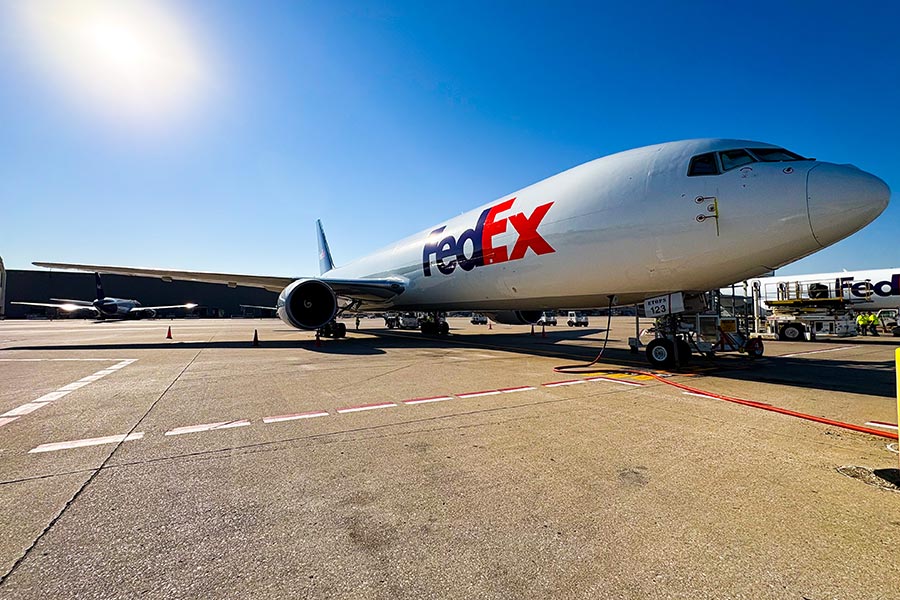Every week, Amárach and Future Proof Insights share exclusive findings from their PRIZM+ ad testing service, showcasing best practice creative advertising in Ireland.
Rockshore’s latest spot, “Time to Show Up,” brings Roy Keane back to Cork in a sequence of events that blends humour, nostalgia and cultural pride.
More than just a funny Keane cameo, this execution is designed to raise the profile of Rockshore’s sponsorship property, the League of Ireland.
By putting one of Ireland’s most recognisable football figures at the heart of the story, the ad ensures the sponsorship feels relevant, visible, and entertaining for fans.
But crucially, Keane’s star power doesn’t get him any favouritism, meaning this is one for the fans.
For marketers, this is an important reminder: sponsorships work hardest when they are activated through credible talent and stories that draw cultural attention to the property.
The story is told without a narrator, just visuals, music, and clever one‑liners that play on Keane’s persona.
From his taxi ride to being refused entry at Turner’s Cross, to squeezing into the Corner Flag, the ad builds a comic but affectionate portrait of Irish football fandom.
It closes by locking Rockshore to the League of Ireland, who together make it “A League of Our Own”.
From a neuroscience perspective, the ad is both entertaining and effective.
Engagement and memorisation spike when Roy is revealed, when the steward delivers her punchline, and when the crowd's roar breaks through at the pub.
Humour and prediction error play an important role, while communal pub scenes generate empathic mirroring, and audiences feel part of the shared atmosphere.
Cognitive load stays mostly balanced, though there are slight dips during the “shut out” sequence where Roy circles the stadium.
A watchpoint is the end card; however, cognitive load spikes sharply: too many elements compete at once, meaning the audience may retain less.
For marketers, the lesson is simple: if you try to show everything, people often remember nothing.
Overall, the creative delivers on Rockshore’s promise: to make fans feel part of something proudly Irish, light, and refreshing.
Best-Performing Scenes
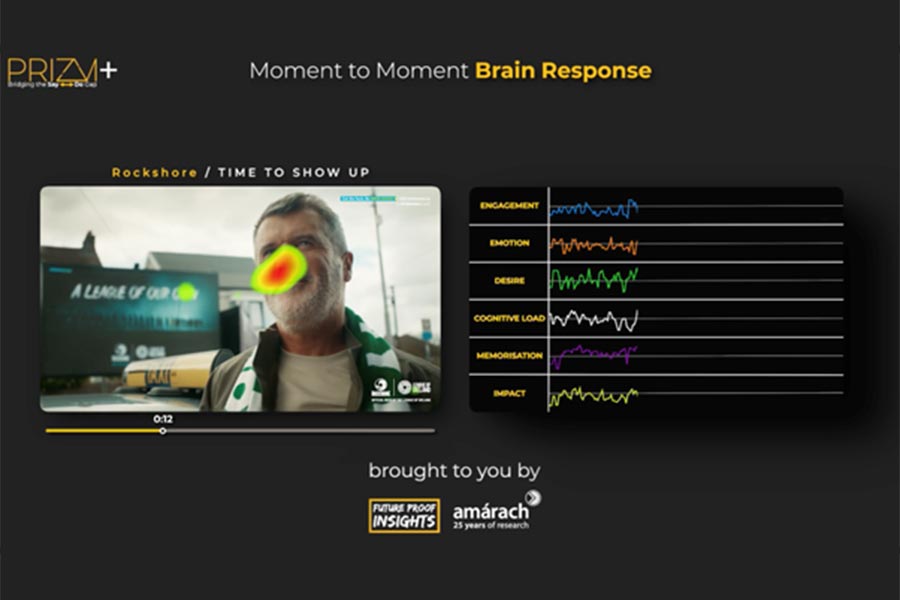
0:11–0:14 – Roy’s Hero Shot
Roy steps out of the taxi, scarf draped, smiling as he approaches the stadium. Neural data shows strong spikes in memorisation and recognition.
Viewers respond to the reveal of a familiar cultural figure, Roy’s presence acts as an anchor, making the message feel authentic and worth remembering.
This is more than just celebrity recognition: it’s how the ad connects the sponsorship property to a trusted symbol of Irish football.
The learning is that sponsorship credibility is strengthened when embodied in a recognisable figure whose persona reinforces the property’s story, and when that figure is clearly tied back to the sponsorship itself, turning a cameo into a signal of brand investment and cultural relevance.
Crucially, the creative concept does not glorify Roy, but instead increases relatability by showing that even he can’t get into Turner’s Cross.
This flips his iconic status on its head and makes the sponsorship feel down-to-earth, humorous and accessible.
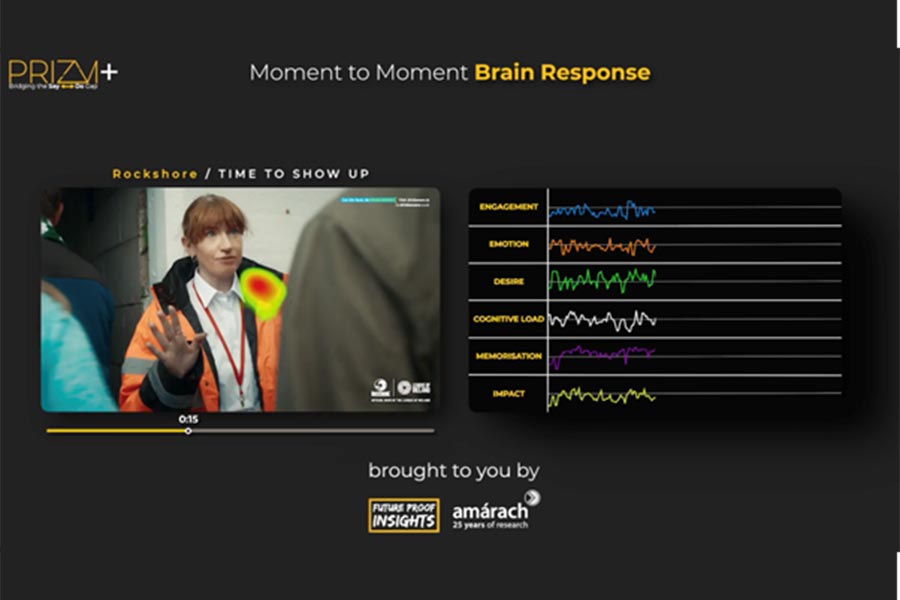
0:14–0:17 – “Roy, it’s my job”
The steward blocks Roy at the gate with a witty callback to his “do your job” mantra. Engagement and emotion lift sharply here, powered by humour and surprise.
This prediction error, the audience expects Roy to walk in unchallenged, but instead he’s stopped, creates memorability.
This moment not only entertains, it also signals that the sponsorship is woven into the culture of the game, not layered on top of it.
Marketers can see the value of humour that grows directly out of character; it surprises, entertains, and anchors the sponsorship property in cultural conversation, proving that the best sponsorship activations feel like part of the story rather than an add‑on.
Underperforming Scenes
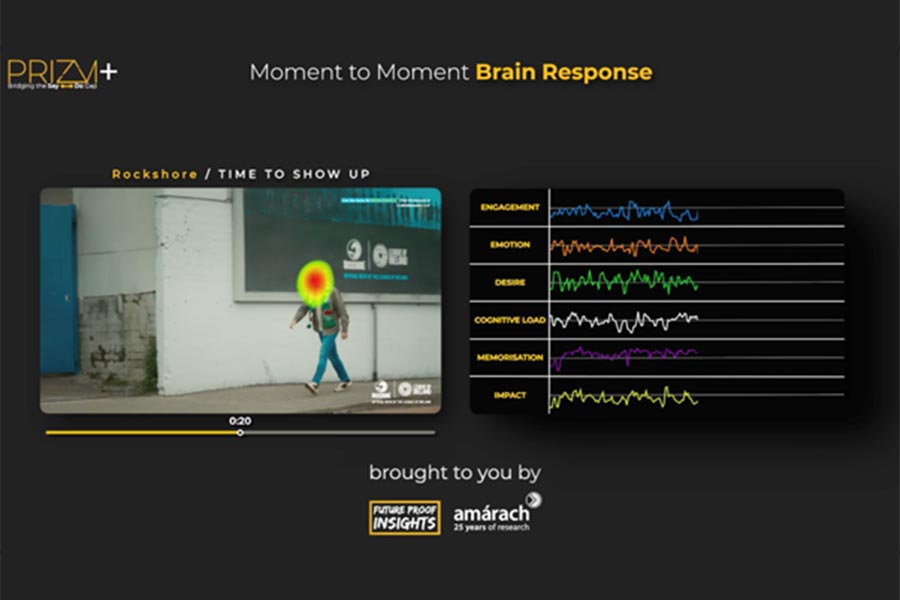
0:17–0:21 – Shut Out
Roy circles the stadium, hearing the roar from inside. Neural data shows a dip in emotion while cognitive load edges higher.
The scene works to build tension, but without a clear emotional payoff, attention softens.
For marketers, the insight is that mid‑section transitions risk losing energy unless punctuated with a moment of release, human expression, humour, or a fresh visual beat.
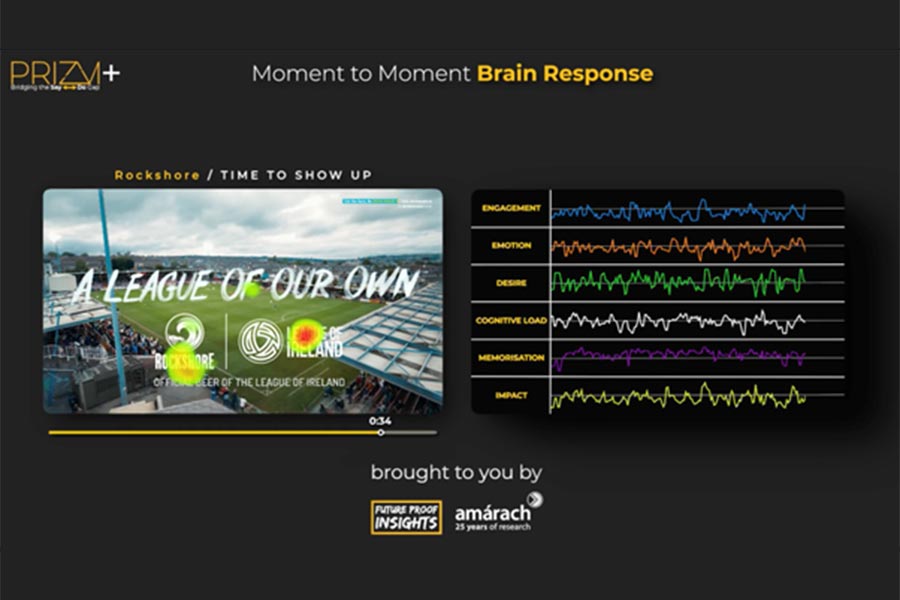
0:32–0:34 – End Card
The final lock‑up includes Rockshore, the League of Ireland, and multiple small details. Neural data shows a spike in cognitive load here; we can see from the heatmap that viewer attention is being split between too many competing elements.
When attention is divided like this, encoding drops and audiences often retain less.
The effect is that, despite good intentions, the viewer may leave remembering little of substance.
Information needs to be presented in a viewer‑friendly way; we need to help people process it, not assume because it’s there that they will.
One brand cue, one property, one message. That’s what sticks.
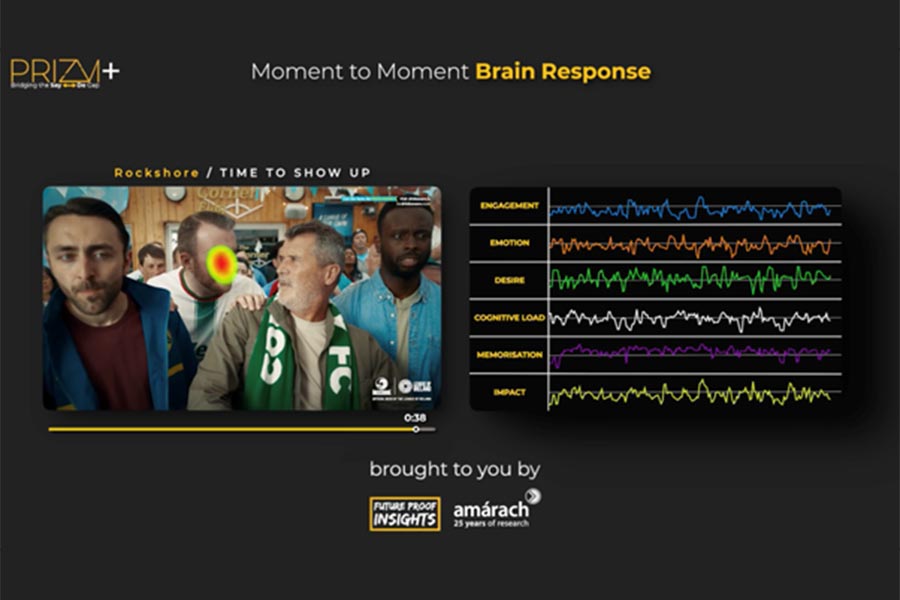
Post‑Credit Beat
The gag of Roy taking someone’s spot his spot earns a smile, but by this stage, engagement has eased back from its earlier peaks. The viewer has assumed the narrative is closed, and as such, engagement dwindles. As a result, the scene adds some colour, but doesn’t add much memorisation.
Marketers should note that while “post-credits” scenes work very well in the movies, in short exposures like advertising, engagement is fleeting if we give a viewer an opportunity to engage elsewhere. They will… Key content should always come before the end card; audiences have been conditioned to assume the story is over.
Behavioural Impact (COM‑B)
Survey data shows that the ad scores highest on Capability: audiences clearly understand Rockshore’s role as sponsor and supporter of the League of Ireland.
Opportunity also performs well, with the pub setting grounding the brand in real fan culture. Motivation is somewhat lower; viewers enjoy the humour and cultural cues but are less immediately driven to action.
In practice, this means the sponsorship is recognised and credible, but to convert that into behaviour Rockshore needs to give fans a nudge, whether through a prompt to order Rockshore at the bar, or a mechanic to engage with the LOI.
Demographically, the ad performs strongest with male viewers aged 25–44, a sweet spot for both football and lager. Exposure impact is high, with repeat viewers showing stronger intent, while targeting impact suggests relevance matters; football fans in particular resonate most.
The takeaway: the ad builds belief and understanding of the sponsorship, but to convert this into action, Rockshore must turn cultural pride into behavioural prompts.
Lessons for Marketers
- Activate sponsorships through culture: Roy Keane’s presence works because it ties Rockshore’s sponsorship to authentic Irish football culture. What matters is not just featuring him, but embedding his character and pop culture into the activation. By flipping his iconic status to make him more relatable, the sponsorship feels part of the fan experience.
- Humour as a differentiator: The steward’s line shows how humour rooted in character and culture delivers memorability. It’s not humour for humour’s sake, but humour that proves the sponsorship is lived and understood.
- Keep transitions alive: Mid‑sections need small beats of human expression or humour to sustain attention before the payoff. Without them, sponsorship activations risk losing energy.
- Simplify the lock‑up: Neural data shows clutter at the end card raises cognitive load and weakens recall. Streamlining end‑frames to one clear sponsorship cue ensures audiences process and remember the link.
- Convert belief into action: Motivation lags. To translate sponsorship credibility into behaviour, Rockshore should add prompts that connect pride to purchase or participation, whether ordering Rockshore at the bar or engaging with the LOI.
“Time to Show Up” delivers a funny, affectionate take on Irish football that boosts Rockshore’s sponsorship profile. With a cleaner lock‑up and clear prompts to action, it could move from shared pride to shared pints.


